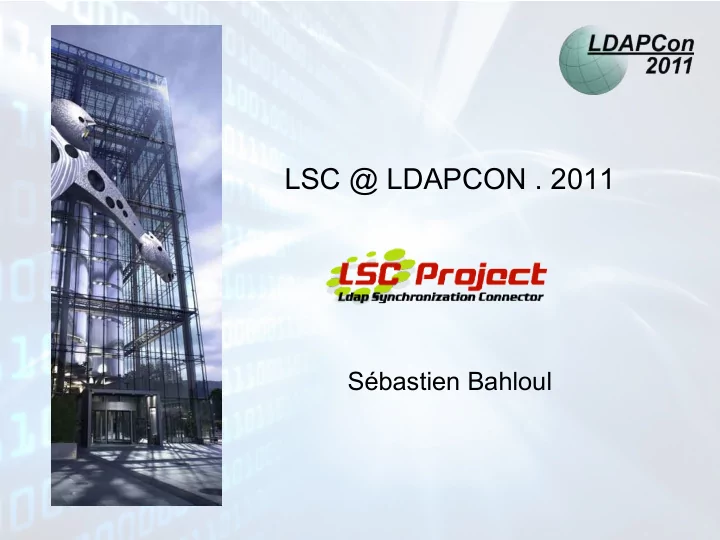

LSC @ LDAPCON . 2011 Sébastien Bahloul
About me Developer and software architect 10 years experience in IAM Recently hired as product manager by a French security editor, Dictao, providing : – personal and server signature, – certificate and signing validation, – electronic vault – multi-factor authentication 11/10/11 Page 2
Agenda Solving one issue : directory synchronization The LSC project Demonstration Open question : how to get updates notification ? 11/10/11 Page 3
Handling multiple data sources ? 11/10/11 Page 4
Why ? Most of us have already done a directory migration Who has already written a synchronization script ? that has been used once ? Most of LDAP servers are not providing either a way to synchronize either heteregeneous data or homogeneous data with other implementations 11/10/11 Page 5
Introduction Automatic synchronization tools − If they already exist, they are quite expensive Directory / database- specific replication Application- specific connectors (AD, SAP, etc) − What about the rest? Between different databases, directories, files? Different data models? Using standards: LDAP, SQL, etc...? 11/10/11 Page 6
Goals – functionality Read/write to any repository − Database or LDAP directory or ? − Standard LDAPv3 operations − Connectors for databases Transform data on-the-fly − Adapt to a different data model − JavaScript based engine to manipulate data Adjustable updates: force values, insert defaults, merge new values with existing ones, no change... 11/10/11 Page 7
Goals – usability Quickly implement a new synchronization Highly configurable − What exactly do we read? − Powerful transformations (correctness is important) − What exactly do we write? Run fast (performance is important) Easy to setup => Fill the gap between the Perl script and the Enterprise ETL 11/10/11 Page 8
About LSC Project What is LSC? LDAP Synchronization Connector − Open Source project − BSD licence − Written in Java − 6 years in the making − 4 years ago LSC-project.org created − ~10 regular contributors − Website: http://lsc-project.org 11/10/11 Page 9
LSC : read and write « everywhere » Original and best supported connector to LDAP directories Additional sources: NIS, database, LDIF/CSV files, Web Services Additional destinations: Scripting, database Extensible API for custom referential support 11/10/11 Page 10
Standards based – Wide support Any LDAP server should be supported, tested on: − OpenLDAP − OpenDS/J − Sun DSEE − Microsoft Active Directory − Novell Directory Services − IBM Tivoli Directory Server Any database with a JDBC connector, tested on: − MySQL, PostgreSQL, Oracle, MSSQL, HSQLDB, ... 11/10/11 Page 11
Features Full « Refresh » or « RefreshAndPersist » with dryrun support On the fly event handling Plugin API : connectors, libraries, scripting languages JMX and command line remote invocation Advanced libraries : encryption, Active Directory, localized strings, ... 11/10/11 Page 12
Synchronization rules Use your preferred language to write LSC rules! LSC built-in and historical support for JavaScript Extensible to any JSR 223 compliant language : – Php – Groovy – Unix tools (awk, TCL), – Python, Ruby, Scheme (Lisp) – ... 11/10/11 Page 13
LSC synchronization principles First step: sync − Get a list of all pivots from the source − For each pivot Read the source object Search for the destination object with pivot Build up desired destination object by applying transformations to source object If the destination object exists, calculate modifications Apply: create or modify 11/10/11 Page 14
LSC synchronization principles Second step: clean (optional) − Get a list of all pivots from the destination − For each pivot Search for the source object with pivot If the source object doesn't exists, delete from destination Apply: delete Alternative step: asynchronous mode − Get the next source object to synchronize 11/10/11 Page 15
LSC : graphical interface 11/10/11 Page 16
Demonstration Simple use case: synchronize identities Involved referential: – A source OpenLDAP directory – Provisioning to: • OpenDJ • PostgreSQL 11/10/11 Page 17
Roadmap Current 2.0 version Event handling ✔ Write to database ✔ Plugin API ✔ Next minor version 2.1 (Q1 2012) Move to a real LDAP API (Apache / OpenDJ LDAP API) ✗ Two-phase commit for file, directory (RFC5805) and database (one-to-many) ✗ Administrative GUI including scheduler ✗ Next major version 3.0 (later) Data reconciliation (embedded database) ✗ Many-to-many design ✗ 11/10/11 Page 18
Try it out! Get involved! Main website: http://lsc-project.org/ − Tutorials: quickstart demo − Reference documentation 11/10/11 Page 19
How to get notification updates ? The current way of handling: – OpenDJ / OpenDS / Oracle / Sun / Netscape : persistent search (draft psearch) – Apache DS / OpenLDAP: LDAP Content Synchronization (RFC4533) What would be the best way? – Ldap Client Update Protocol – Per product logs (retro/external/access/...) – Application-side database 11/10/11 Page 20
Thanks for your attention! Any questions?
Recommend
More recommend